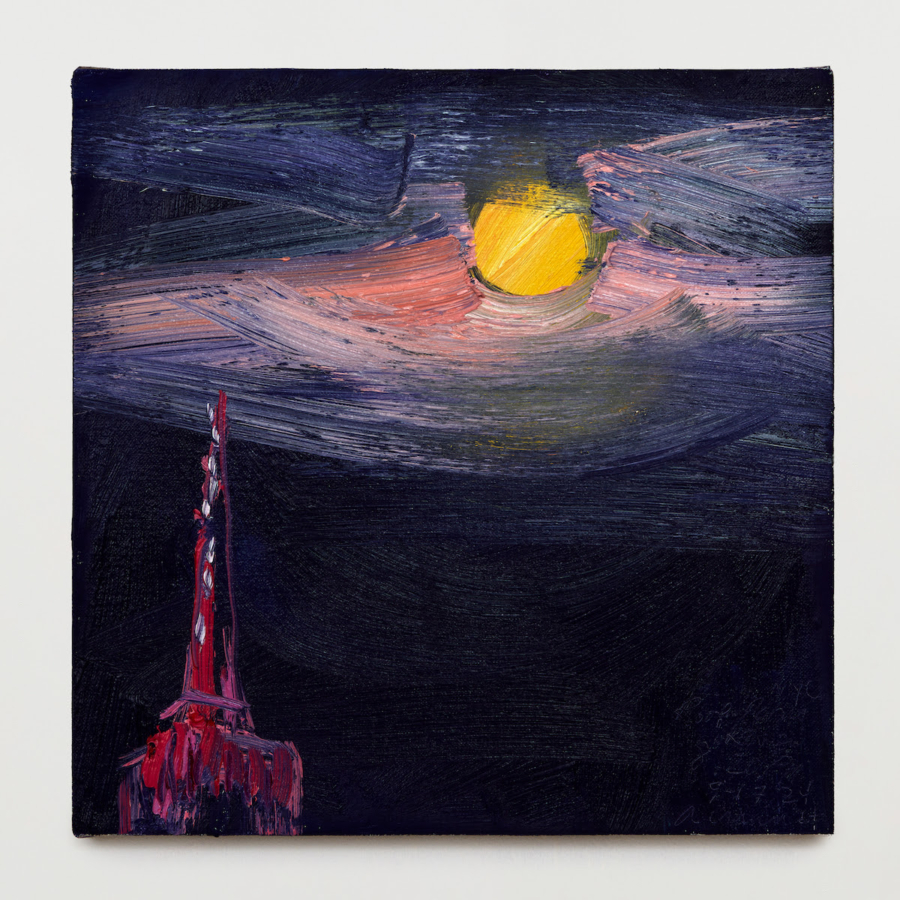August 15, 2020
Download as PDF
View on CoBo Social

Maja Ruznic, Reshuffling For Tomorrow’s Ghosts, II, 2018, oil on canvas, 140 × 102 cm.
The Three Women coalesce into each other with the temperamentality of weather. The first breathes onto the pane of the canvas like condensation. She is hunched, spent, half vanished. Her head is absorbed like a violent blow by the second whose pose is as a pillar of salt, her shaft-like form seemingly sandblasted rather than painted. A third is in attendance, a spirit whose trunk is a shimmering contrast to her soggy torso, inclining with the drenched force of lake-blue gravity. There is a feeling of barometric pressures shifting, a warm softness against hot sand, a moody blue torrent inbound. The paint is not so much brushed on (there is barely a visible brush stroke) but rather mysteriously orchestrated in an alchemy of atmospheres. There is an unsettling grit that sporadically crawls forward from the weave of the canvas: an urgent, itchy surface of prickling stubble, and a sprinkling of spores. When I return to this painting in a few days, will I find it has sprouted hair, lichen and moss? In this terrain of rust, pollen, mold, wind, blood and stone, we meet our Three Women. The entangled trio seems to come to us from the past and the future, to confront us in a slippery present.
Undoer of Knots emits a warm glow. The canvas has inhaled pigments as puffs of colored smoke: hues of moss, rust, flour, bruise, yolk, sour, and sand. It’s a sun-drenched, impressionist forest scene, a soft and sensual space. The painting opens a gentle forum for contemplation, a state of mind which represents merely half of its split personality. Unexpectedly, the pleasure morphs into terror: a tormented ghost is held captive. The canvas senses its presence: those tormented, suffering eyes which long to deliver some unknown message. Undoer of Knots emits a visceral horror.
Undoer has an antidote, one that offers solace from the terror. Love Letter to Tomorrow’s Ghosts lures us into a hedonic cove. Time is thickened, slowed in the liminal gelatine of the heart’s rhythm. The surrounding hum is a resonant, baritone blue. Velvet tones describe hands that melt as they reach and grasp. Refugees from the pain of the world: two violet- tinged, nebulous lovers are easing into oneness, before embarking on a graceful dissolution. An emotionally evocative abstraction materializes and dematerializes, loosens and tightens, integrates and diffuses.
Delightfully Chagallesque characters enact a Stone Soup-like folk tale: Reshuffling for Tomorrow’s Ghosts. A dream creature, with the face of a cat or owl, stands guard, tall on its peculiar body, supported by a single booted leg. A shiny, pink-headed man limbos in the foreground, with a lean back and a belly roundly stuffed. The disembodied torso of a woman with a sweet-sour cloud of citrus-green hair floats above him. Her fingers are busy casting a spell, or perhaps weaving an invisible thread. Or holding the face of a disappeared loved one? She gazes into eyes that we cannot see. It’s midnight on the beach, and the sound of waves is softened by the full moon’s light warming the sand.
Maja Ruznic’s paintings harness the magic minerality of paint as a psychic potion, and the metaphysical potential of the canvas as a portal for summoning spirits. The figures are seemingly not premeditated, but are manifested through the process of painting. In her own words, Ruznic describes the canvas as “a net that catches the ghosts.” The works dwell not only in the spirit realm, but evoke a sacred connection with the earth. These paintings speak to today when the earth is literally burning and spiritual reconnection to natural rhythms is critical. Ruznic is an artist who moved recently from downtown Los Angeles, leaving behind the neon pinks and feverish palette of her earlier paintings, to the desert of Roswell, New Mexico. We feel the sand, the sun, and the scorch, through a painterly hand that projects a psychological and tactile landscape into her mystical paintings.


